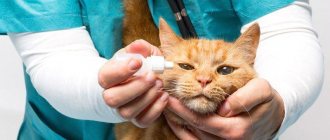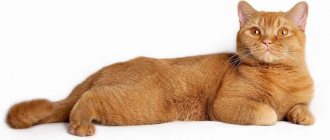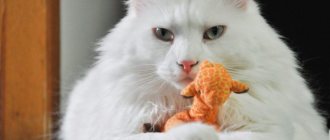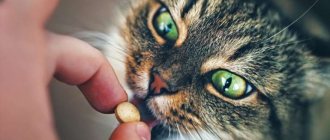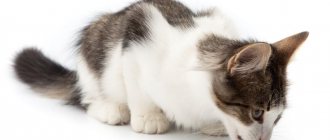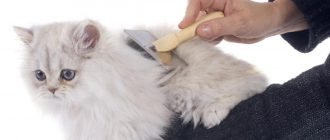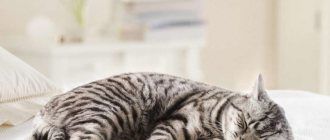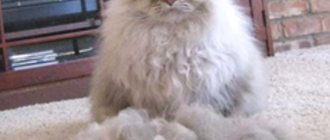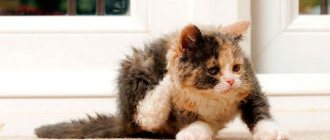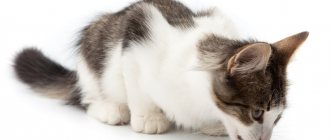Under normal conditions, the source of calcium (as well as many other minerals and trace elements) in a cat's diet is raw bones. There calcium is contained in the most bioavailable form.
Unfortunately, feeding meat and bone products is not always possible here and now. Some cats, when switching from industrial food, refuse bones for a long time (this is not a reason to give up - see our article “Lost in Translation”), but a pronounced deficiency of calcium in food becomes evident within a few weeks (for kittens) or months (for adults). critical. There are also medical indications for complete or partial elimination of bones in the diet, for example, a diet for cats with chronic renal failure.
This is where artificial additives come to the rescue.
Trade names of drugs are given as an example. You may find similar supplements on sale from other manufacturers; they are no worse, but always pay attention to the composition - it should contain calcium in one form or another.
Deficiency and consequences
At each stage of life, a cat should receive the required amount of calcium appropriate to its age and needs. Without calcium, processes such as the transmission of nerve impulses and muscle contraction are not possible.
Proper calcium intake – in the right amount and at the optimal period. If a cat lacks a microelement, this immediately affects its health, and the consequences are different at each age. For example, if a kitten lacks calcium, then the situation is aggravated by pathologies in skeletal development. Lack of calcium in a cat in adulthood and old age leads to brittle bones - the possibility of fractures increases. Adult pets feel a lack of this element in the fifth month - that is, five months after the body experiences a shortage. In kittens this happens much faster.
It also happens that a cat has high calcium - what to do in this case? Of course, stop giving your cat calcium. It should be remembered that pets at different periods of life require an increased rate of this microelement - especially at a young age, during lactation. Excessive calcium content in a cat’s body is fraught with bone pathology and osteochondrosis.
It is important to adhere to the consumption norm. Is your cat lacking calcium? Use an approximate calculation of consumption - only a veterinarian will provide more accurate information.
- kittens - 440 mg per 1 kg of weight ;
— adult cats – 45 mg per 1 kg of weight .
For example, an adult cat weighing 4 kg should receive 180 mg of calcium per day .
Any living organism needs calcium and phosphorus; this is a well-known fact.
However, cat owners are most concerned about the balance of these minerals. Postpartum eclampsia and primary hyperparathyroidism are associated with calcium deficiency. More than one cat owner has encountered inflammation of the urinary tract caused by phosphorus salts in the urine. How much calcium and phosphorus should be supplied with food, where to get them in the right quantities and how to ensure balance, is this possible in principle - these are perhaps some of the most troubling questions for those who are thinking about switching their pet to a species-typical diet. Functions of calcium and phosphorus
Calcium is not only strong bones, but also working muscles and the heart, ion balance, transmission of nerve impulses, blood clotting, regulation of glycogenesis and other processes. The bulk of calcium is concentrated in the skeleton, the rest is distributed in the intercellular fluid.
Phosphorus is part of the structure of proteins and DNA, participates in metabolic energy processes and ensures the functioning of muscles and the nervous system, maintains acid-base balance and ensures skeletal strength.
Together with calcium, it forms hydroxylapatite, which is what bones are mainly made of, where the bulk of this mineral is located. Calcium absorption
Calcium coming from food is absorbed into the blood in the intestines, and excess is excreted in feces and urine. To absorb calcium, vitamin D is necessary, which cats, unlike humans, cannot produce from provitamin; it must come from food. Calcium circulates in the blood constantly. If there is not enough calcium coming from food, its concentration in the blood decreases. In this case, the parathyroid glands produce a hormone that provides an incentive to flush the mineral out of storage, that is, from the skeleton, and nutritional hyperparathyroidism occurs. Bones become fragile and easily break from the slightest load, and sometimes even without it. The diagnosis is made based on the amount of calcium and phosphorus in the blood and skeletal x-rays. The image will show insufficient bone mineralization, or the so-called glass skeleton, in the early stages of nutritional hyperparathyroidism, when changes in blood calcium levels are not yet so noticeable. Kittens and young animals are more likely to suffer from calcium-deficient diets. The problem can be solved quite simply in one or two months – by balancing the animal’s diet with calcium and phosphorus.
Hyperparathyroidism can also be primary. This is an endocrine disease that has nothing to do with nutrition. The parathyroid glands produce too much of the hormone, causing bone mineralization to suffer. Often primary hyperparathyroidism is associated with oncology or hyperplasia of the parathyroid glands.
Calcium absorption can be interfered with by certain fatty acids in food.
In the intestines they form insoluble compounds with the mineral, which are excreted in the feces. In this case, both calcium and fat are lost. Absorption of phosphorus
Phosphorus also enters the body with food. Vitamin D, although it increases the absorption of phosphorus, is not necessary for its absorption. As the calcium/phosphorus ratio in cat food increases, the absorption of the latter decreases. If there is four times more calcium in food, then phosphorus absorption decreases to a critically low level. Magnesium also reduces the absorption of this mineral. It is interesting that the intake of phosphorus into the body directly depends on the type in which it is obtained: absorption from organic matter is two times less than from inorganic sources.
Increased levels of phosphorus stimulate the parathyroid gland to produce a hormone that enhances the excretion of the mineral by the urinary system. Insufficient levels of phosphorus in the diet lead to weakening of muscles and ligaments, anemia and acidosis. Phosphorus deficiency is very difficult to achieve when eating raw meat, but if the cat eats a diet consisting primarily of plant sources and/or receives supplemental calcium, then deficiency is quite possible.
Increasing the amount of phosphorus reduces the ability of the urinary system to remove creatinine, the end product of protein breakdown, and also reduces the amount of calcium circulating in the blood. This signals the parathyroid gland to produce the hormone. Calcium from the skeleton enters the blood, the bones become fragile, and here it is, secondary hyperparathyroidism. In addition, high doses of phosphorus are directly associated with severe kidney disease, calcification of blood vessels and heart valves.
These two minerals - calcium and phosphorus - are inextricably linked with each other, are necessary for the functioning of the body and must come from food in the correct ratio.
Ideal calcium/phosphorus ratio
In muscles and organs, the amount of phosphorus is hundreds of times greater than the amount of calcium. In bones the ratio is diametrically opposite. In nature, a cat eats caught prey whole. The skeleton of small rodents and birds makes up approximately 7-10% of their weight, in cubs it is slightly more. For example, in an adult rabbit, the bones weigh about ten percent of the total body weight, in a baby rabbit - about fifteen. But the mineralization of the skeleton depends on age: the bones of young animals contain less calcium and phosphorus than those of an adult animal.
Thus, if a cat’s diet contains about 10% pure bones, then its body will receive the required amount of calcium and phosphorus in the required proportions. This is the easiest way to maintain balance.
The American Association of Feed Control Officials (AAFCO) recommends maintaining a calcium/phosphorus ratio of 1.1 to 1.3/1 in cat food.
The ratio of these minerals in a whole mouse carcass is approximately the same. However, you should not measure the amount of calcium and phosphorus down to the milligram, especially since this is impossible. The book Clinical Small Animal Nutrition, published by Walsworth Publishing Company, notes that healthy cats will do well at a ratio of 0.9/1 to 1.5/1. The ratio of minerals in each serving or each day is not as important as the overall, long-term balance over the months. If you want to count
Spongy bones suitable for cat nutrition are found in the spines and heads of birds and small rodents, but they cannot be found on sale in their pure form. So how can you calculate the required amount of meat and bone products when preparing your own diet? To do this, you need to know how many bones are contained in a particular meat and bone product.
For example, in a chicken neck with skin there are 36% bones, and without skin - 50-70%. The backs, which are designated as soup sets on price tags, contain 45% suitable bones. Turkey is a meatier bird, 42% of its neck is occupied by vertebrae, and in a whole cut and gutted rabbit there are 25-30% pure bones.
Thus, by adding 200-250 grams of chicken necks to one kilogram of boneless products, you can get the required 10% of clean bones in your cat’s diet.
How can you replace bones?
If for some reason your cat cannot receive raw bones, they can be replaced with calcium supplements. This is not the best way to eat and should not be used on a regular basis unless there is no other option.
In first place is calcium carbonate, which is found in large quantities in eggshells. It is one of the best sources of calcium after raw bones. The supplement is easy to prepare at home. To do this, the shells need to be freed from the films, fried in the oven for about 10 minutes and ground into powder. To maintain the calcium/phosphorus balance, you need to add about three grams of shell powder per two kilograms of boneless meat.
In second place are compounds of calcium and organic acids, usually lactate or citrate. Although these compounds are easily broken down to release calcium, it is important to remember that these supplements are synthetic and not natural. Consequently, mineral absorption from them cannot be accurately predicted.
Bone meal is sometimes recommended as a calcium supplement. But this is far from the most suitable option. Firstly, bone meal contains phosphorus in addition to calcium, and it will be very difficult to ensure a balance of minerals when adding it to boneless meat. Secondly, it is impossible to know for sure from which animal bones and for what purpose this flour was produced, whether it is a fertilizer, or whether it is contaminated with heavy metals.
In any case, ensuring calcium and phosphorus balance through supplementation should be temporary and strictly necessary.
Only raw bones can provide the best ratio of minerals and their proper absorption. Briefly about the main thing
Calcium and phosphorus are necessary for the existence of any organism. A deficiency or excess of both can lead to health problems. In a cat's food, one part of phosphorus should contain 1.1-1.3 parts of calcium. These minerals are best absorbed from raw bones. To ensure the necessary balance, a cat needs only 10% of its food to consist of pure bones. Getting a balanced diet is not difficult: to a kilogram of boneless meat products you need to add only 200-250 grams of chicken necks.
Sources of calcium for cats
If pets are naturally fed, it is important for the owner to consider where they will get calcium from. As for meat, this is a controversial source of calcium, because most of the phosphorus enters the body with it - but the cat receives very little calcium from meat. It is important to consider the ratio of phosphorus and calcium in the diet. The norm for adults is 1:1.2 or 1:1 . For kittens – 1:1.4 . To the question “ can cats have calcium? ” there is only one answer – it is necessary , and regularly . If, when fed with balanced food, the cat receives its daily requirement - calcium in cat food is necessarily taken into account, then with a natural type of nutrition, all responsibility falls on the shoulders of the owner - it is he who chooses the source of calcium for the pet.
It should also be noted that calcium is not absorbed by cats from foods of plant origin - we have to look for alternative options.
Bone flour
- Formula: Mainly hydroxyapatite, Ca10(PO4)6(OH)2
- Trade names: Canina Calcina Meat Bone Meal
- Calcium content: 13.6% - Canina supplement, may vary depending on source.
- Phosphorus content: 13.9% - Canina supplement, may vary depending on source.
Often becomes the first choice of the owner. After all, what is a better replacement for bones than bone meal? But it's not that simple. Unfortunately, bone meal differs from raw meat and bone products not for the better, since it is, firstly, a thermally processed product (less digestible), and secondly, it is made from low-quality animal waste.
Most importantly, bone meal's calcium to phosphorus ratio is only 1:1, making it difficult to maintain Ca:P balance in the diet.
Bones and meat
Meaty bones are a traditional way for cats to obtain calcium. But in this case, you must adhere to certain rules, otherwise you cannot avoid intestinal blockage or other, more serious problems.
However, everyone knows the experience of wild cats - they catch mice and birds, eating them completely - with bones, thereby replenishing the calcium level in the body. Owners feed their tailed pets selectively - mostly boneless meat. So should you give your cat bones?
Bone products are an excellent source of collagen, calcium, chondroitin, and glucosamine.
— Do not give your cat sharp bones, which can injure the intestines and lead to internal bleeding. These are the tubular bones of the wings and legs.
- Cats should not be given medium or large bones - these will get stuck in the esophagus or throat.
- Choose suitable bones with meat from the whole carcass. Alternatively, grind the selected parts in a meat grinder or break into small pieces with a hammer.
— Do not give your cat bones that have undergone heat treatment. When boiling or frying, the chemical composition of the bone changes: protein, vitamins and fat go into the broth, and calcium phosphate loses its digestibility.
Contraindications and side effects
It should not be given to cats if there is an excess of the microelement in the body. If your pet is allergic, then vitamin complexes must be selected with caution, because they quite often cause various reactions. It is not advisable to give medicine to cats if they have kidney disease, hyperparathyroidism and some malignant tumors. It is necessary to choose a complex for kittens with a veterinarian.
Side effects include allergic reactions, nausea, vomiting, and diarrhea. The cat may have a stomach ache and flatulence. Sometimes disorders of the nervous system and psyche appear. If the dosage is too high, hypercalcemia may develop. If your pet experiences any unwanted effects, you should notify your veterinarian. Most likely, the medicine will have to be discontinued.
Vitamins with calcium
Veterinary pharmacies offer a large number of calcium preparations for cats. Their selection is carried out in accordance with certain rules:
- do not give drugs “by eye” or for a long time - hypervitaminosis is even worse than a lack of vitamins. Do not ignore the instructions and rules for taking vitamins;
- if the cat eats raw boneless meat, purchase vitamin complexes without phosphorus;
- before constantly taking any drug with calcium, make sure there are no allergic reactions - monitor your pet’s health;
- if the pet is on a special professional food, then it contains all the Vitamins that cats need - taking additional supplements is discussed only with a veterinarian.
Cottage cheese
Calcium for cats is also found in dairy products. However, milk cannot be digested by cats older than 3 months and can cause diarrhea. Cheese is a fairly heavy food for cats and should only be used as a treat. But in terms of calcium, cottage cheese is valuable.
Medium-fat cottage cheese contains 111 mg of calcium and 150 mg of phosphorus per 100 grams. But we remember that the balance of calcium and phosphorus in a cat’s food should be 1.2 (calcium) to 1 (phosphorus) or at least 1:1. Those. in cottage cheese this ratio is not maintained: the bias in favor of phosphorus, as in meat, is simply not as pronounced. And if we take into account that cottage cheese cannot form the basis of the diet and is used only as a small part of it, it turns out that with the help of cottage cheese alone the balance of calcium and phosphorus cannot be achieved. In addition, not all cats agree to eat cottage cheese.
However, this product can be additionally calcified - and such a move can indeed balance the diet. To do this, you need to purchase calcium supplements from a veterinary pharmacy and add them to cottage cheese or other products.
Calcium supplements for cats
There are several common calcium compounds found in vitamin and mineral supplements for cats.
Calcium carbonate
This compound is found in egg shells and is also found in chalk and shells. Its digestibility is 20% , in addition, side effects are possible with excessive consumption of the supplement. It is better to exclude calcium carbonate from possible options and not consider this calcium requirement for cats.
Calcium gluconate
This is the most famous compound in Russia, but, unfortunately, only 3% . As a vitamin supplement, it is better for cats to replace calcium gluconate with a more suitable option.
Calcium lactate
This is a good calcium compound for kittens up to three months of age, who are still digesting lactose - unlike adult cats. Lactate is contraindicated for cats older than three months - it causes digestive problems.
Calcium citrate
A suitable compound as a vitamin-mineral complex for cats. Digestibility is 44% . This figure is small, but still higher than in the case of calcium carbonate and calcium gluconate. The advantage of use is the low price and the absence of side effects from taking it even if the dosage is exceeded. In the case of calcium gluconate, it is much more difficult to calculate the dosage for a cat.
For dogs and cats, calcium citrate is an optimal dietary supplement.
Calcium chelate
The leader in the digestibility rating is calcium chelate. It is absorbed by the cat's body by 90-98% . This is facilitated by the presence of calcium molecules together with amino acids. With the previously described compounds, the body needs to do additional work - perform long chains of chemical reactions. The cost of the chelate is high, and it is also more difficult to find such an additive. But it's worth it!
Check the prices for vitamins for cat fur - such complexes should be given to cats in courses or on the recommendation of a veterinarian.
Recommended calcium content in dog food
So, the European Federation of Pet Food Manufacturers gives manufacturers the following recommendations on the dosage of calcium in ready-made complete feeds, calculated per 100 g of feed dry matter:
- In food for adult dogs - minimum 0.50–0.58 g, maximum 2.5 g;
- In food for puppies in the early period of development (under 14 weeks), pregnant and lactating bitches - minimum 1 g, maximum 1.6 g;
In puppy food during the later period of development (from 14 weeks and older), the dosage of calcium should differ depending on the size of the breed:
- for puppies of breeds whose adult weight is less than 15 kg, during the entire late growth phase (from 14 weeks) - at least 1 g;
- for puppies of breeds whose adult weight is more than 15 kg, continue this dosage until they reach the age of 6 months, and only after this point reduce the calcium level to 0.8% in the dry matter of the food.
For growing puppies, a calcium level of 0.8 g per 100 g of food dry matter has been determined to be medium optimal. However, according to the same GOST, calcium in dog food of certain breeds, especially in the rapid growth phase (especially in those breeds with low energy needs), should not be higher than the specified value (0.8 per 100 g) , this is the maximum permissible level for them.
During the later growth period, the calcium content in the feed should be up to 1.8% of the dry matter of the feed. This applies to all breeds of dogs, including giant ones, except Great Danes. This breed is considered the most sensitive to calcium levels, so it is advisable to feed these adolescents a diet with a maximum calcium level of 1.6 g per 100 g of dry matter of food.
FEDIAF comments say that feeds rich in calcium (where its level approaches the specified maximum) should be balanced in other respects - in particular, the dosages of zinc and copper can be increased.
Vitamins for cats with calcium
When it comes to the health and longevity of furry pets, the responsibility falls on the owner - cats and dogs simply have no one else to rely on.
The best vitamins for cats with calcium are natural. Such supplements are balanced in composition and can guarantee good digestibility and effectiveness after a course of administration. In this case, it is completely safe to buy calcium for cats.
| Sea calcium - 1023 rub. | Eggshell powder - RUB 1,259 |
cdVet Fit-Barf Sea Calcium contains one valuable ingredient - limestone from seaweed. This is an excellent option for natural feeding of pets, as it neutralizes excess phosphorus in fresh meat. 100% natural composition guarantees good absorption of the vitamin supplement by cats. We also advise you to familiarize yourself with the prices of vitamins for joints for cats - the calcium content in such preparations is also required.
Fit-Barf Eggshell powder is a natural source of calcium, which fits perfectly into the diet of pets and replenishes the lack of calcium in the body.
| MicroMineral — 1336 rub. | ArthroGreen Classic — 2470 rub. |
Fit-Barf MicroMineral is a mineral feed additive containing seaweed, yeast, malt and grape seed extract. The plant origin of the components is valuable for the body of cats, who receive the supplement daily. They do not overload the detoxification organs - liver and kidneys.
Giving calcium oxalate to a cat is a less attractive idea; vitamins from natural ingredients are another matter.
How is calcium best absorbed?
Calcium is undoubtedly an extremely important mineral, because it is one of the key components of bone tissue. But its metabolism in the body is closely related to the amount of phosphorus that the animal receives with food, as well as with vitamins D and C. The first is traditionally called “antirachitic”, the second helps to optimize the structure of bone tissue, by the way, dogs are able to synthesize on your own.
We think that from the above it is clear that maintaining a balance of minerals and vitamins in the diet in accordance with the age and special needs of the pet is very important for any dog or cat.
Excess calcium is just as harmful as its lack, and at certain periods of life, especially for large puppies, it can have an extremely bad effect on their health. We should also not forget one more point: in order for the calcium received per os and absorbed in the gastrointestinal tract to be included in the bone tissue, each pet needs a sufficient level of physical activity.
The key word here is moderation, that is, measured movement at variable speeds during walks is important, and not constantly lying on the couch or, conversely, heavy physical activity.
Vitamins with calcium for kittens
Kittens require the most calcium. At a young age, active skeletal growth occurs and teeth are formed, so additional calcium supplementation is especially important.
| Milk replacer for kittens - 1260 rub. | FitCroc Cat with reduced protein content - RUB 1,585 | FitCroc Cat - 1994 RUR |
A good idea is to choose premium cat food, in which the calcium level is precisely known, and how much of this microelement the kitten receives per day. In this case, the purchase of additional calcium supplements is discussed with your veterinarian.
Why is excess dangerous?
If a large puppy, during the growth period, eats commercial puppy food with calcium, plus receives additional nutrition (for example, calcined cottage cheese), and is also fed tableted mineral supplements, then such animals may develop often irreversible nutritional hyperparathyroidism - a hormonal disorder, which in its manifestations is very similar to rickets.
According to FEDIAF (European Pet Food Federation), high levels of calcium in the diet have a very negative effect on skeletal development in large breed dogs, especially in the early stages of development. That is why manufacturers are advised to strictly control the calcium content in food intended for large puppies and giant puppies.
For this purpose, FEDIAF has issued regulations - for decent companies this is a kind of GOST - to determine the permissible level of calcium in food for dogs and cats.
Principles of nutrition for kidney disease
The goal of the diet is to reduce the load on the kidneys and improve metabolism. Simple, proven rules will help you achieve this:
- Protein restriction. What protein products should be included in feed for chronic renal failure? First of all, they should be easy to digest. The best sources are dietary chicken, rabbit or lamb. Pork is acceptable, but it is better to avoid beef. It is impossible to completely eliminate animal protein, otherwise the sick pet will begin to lose weight, which will only worsen its condition.
- Minimum phosphorus. Since an excess of this substance is excreted through the kidneys, with chronic renal failure there is a risk of developing hyperphosphatemia. Controlling the phosphate content in the diet is a basic rule, since a sharp increase in their level in the blood leads to fatal consequences.
- Drinking enough. To eliminate the risk of dehydration, your cat should always have access to clean drinking water. It is important to monitor the quality of water; the fewer harmful impurities it contains, the better. Make the best use of filters. You need to change the water in the drinking bowl at least once a day. It’s better to do it twice so that it doesn’t stagnate and accumulate contaminants settling from the air.
- High-calorie nutrition with a balance of beneficial microelements (calcium, omega fatty acids, potassium citrate, antioxidants, vitamins C, E, A, D3, iron, plant fiber). If the weight dynamics are negative, then there are not enough calories (the average norm is at least 3500 kcal per day).
- Accurate calculation. Food portions must be measured every day, adhering to the prescribed therapeutic norm. It is not recommended to overfeed or underfeed cats with chronic renal failure. They need to eat at least 5 times a day, in small portions. Sick pets often have decreased appetite. To prevent them from starving, you can try feeding them by hand or in a playful way. Another way is to slightly warm up the food in the microwave until it is at a comfortable temperature for your cat. Of course, you shouldn't force feed. This will lead to unwanted stress.
If possible, exclude:
- fat meat,
- dairy products,
- seafood,
- salt,
- grain crops.
